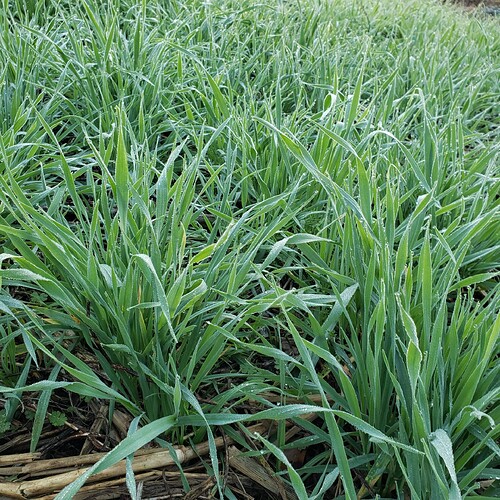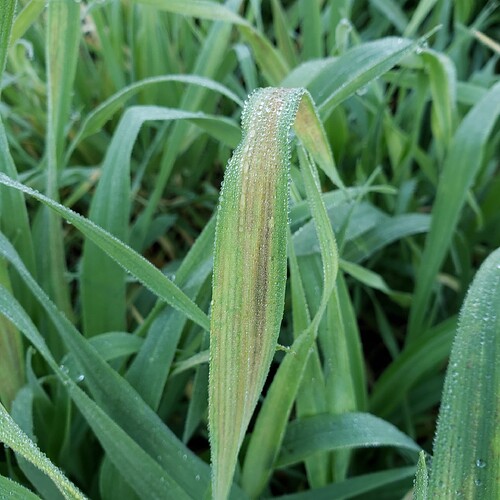For anyone looking for diversity in barley, OSU offers a naked barley blend composed of 753 doubled haploids.
Thank you for the post! I emailed them and they are sending me 100 grams for free! That’s about 2,500 seeds. They said they can give 100 grams for free to any gardener in the US.
I’ve never grown barley before. I’m excited, this sounds like a grex with a lot of genetic diversity!
That’s awesome! What is the winter weather like there? I’m in North Florida, Z8B. Our winters are typically cold and wet with spring temps quickly reaching 80+ degrees. A variety of barley called Gopal grows pretty well here. This year is the largest planting of it yet. Typically it is ready to harvest by mid to late May.
I was told the ONBB was sent out today. It would be cool to compare growth and share updates with you. I will plant it as soon as it arrives. They also said they appreciate reports on it.
I’m in zone 9A, I think the coldest it got last winter was 25F at the extreme. The majority of the rainfall in the year comes during winter. We average only 13 inches per year. The summers are hot and dry. The entire month of August seems like it is 100 Degrees. Average last Spring frost is April 12 and average first Fall frost is October 30.
I’ll plant some as soon as it arrives too, and some in the spring. They said it was a mix of winter and spring types.
That is interesting your last average frost is in April. My zone just got moved up to 9a and our last frost is around the middle of March. Typically our first frost is around the middle of November but nothing yet this year.
In climates like ours that do not get very cold in the winter, you can plant both spring and fall varieties in the fall. In Oregon, they consider spring planting in April, which would never work for me because of how hot/rainy/humid my summers are. My last planting date for spring varieties would likely be no later than early January without suffering low production due to low growth or very late grain fill, and thus also low production. I find that planting in the fall for spring varieties gives them better vegetative growth and establishment which leads to more vigorous tillering and production in spring. Since you’re in a desert climate things may be different. I do not know what heat stress alone does to barley.
I got mine in today! I planted about half of it today and will plant the rest in the next few days. The light blue grains are really cool.
Hey Charles,
Have you planted your barley yet? How’s it doing?
Oh that’s great!! So far, it has no disease issues while the plot of gopal nearby is suffering from two or three diseases which cause leaf yellowing and dark splotches. It is also a shade blue/greener than either gopal or a diverse mix of heritage barley. A little slower to grow as well but healthy plants. I planted mine late November.
Oh, this is interesting. I was going to put in a small plot of black hulless barley from Baker Creek, but if they’re still taking requests this might be a way to get some diversity and find a more adaptable variety for my spring planting!
Awesome! It would be great to have more people growing this beautiful mix.
I just put in a request for some. Hopefully they’re still sending them out! ![]()
They’re so beautiful!!!
Lowell,
I estimated the number of seeds and with recommended spacing I figured I had enough for 100 square feet. I prepared a 10 foot by 10 foot spot of ground by using a stirrup hoe and adding a bit of biochar and worm castings. I planted around Thanksgiving. Only about 20% seems to have sprouted, and it is about 2 inches tall. When it turned colder in mid December, the growth slowed way down. After some rain a few weeks ago, weeds are sprouting and are growing while the barley seems dormant. I’m going to try and weed it as best as I can without disturbing the barley that has sprouted.
The Barley Blend said that it was a mix of winter and spring barely, so I’m hoping that when spring comes more of the seeds will sprout.
In any case, I wanted to plant it and sort of neglect it and see what survived in my conditions and save seed from that. With the great genetic diversity in the blend, I hope to develop my own barley landrace. Here’s a picture of my 10’x10’ plot.
Very cool to see this. I am curious, are we really still thinking of climate in terms of ‘Zones’? I feel like the zones are very antiquated and inappropriate for what is actually occurring on a global scale. We have a range or a zone, sure, but we seem to all be routinely prone to absurd ‘Extremes’. Take the recent Arctic blob of this past month. It blanketed nearly the entire US outside of California. In an El Niño winter, where we’ve personally been warmer and wetter as per historical trends, we had the coldest day we’ve ever recorded on our farm: -36F on our front porch. A week later we were in the 20’s and low 30’s. I personally think they need to modify the Zone maps to explicitly discuss Extreme Ranges and anomalies. I’ve been calling this progression: Global Weirding for over 20 years. This also doesn’t get into microclimates within a region or a Zone. Anywho, I digress. Just my own thoughts on the matter.
Don’t forget, as well, in the winter months it isn’t necessarily the temperatures or the weather with the plant friends as much as it is the light cycle. It is possible, if you’re planting seeds around Thanksgiving with conditions for germination and initial growth they aren’t adjusted for a decreasing light cycle as you head toward Solstice. Typically, in my temperate experience (further North Latitude than you Florida and Arizona folks - winter LOL), when I see a Fall or spring planting…I know these seeds are tailored to survive the colds of winter; cryo-stratify; then germinate at thawing and frost. I, personally, would treat barley in your areas as freshly sown in the beginning of spring past the threat of frosts. If you’re getting down to 25F randomly in winters that is going to kill your young sprouts. Food for thought.
Thanks for sharing, Lowell. This will be an enjoyable plot next to my flour corns!
That is interesting to hear. I’ll provide some photos below of mine. I noticed low germination as well but still had much better germ. Probably 70% of the seeds sprouted. We planted the same time of year. Did you get yours into the soil when you planted or broadcasted?
Really hoping they’re still sending out packets. I realized that not only can I grow some here at home, but my community is also going to be building a new community garden this year and I’ve joined the planning volunteers. Adapting a hulless barley population to the area could be useful for the garden – we could incorporate it into a cover crop mix for the off-season alongside some legumes and such.
I broadcasted, then walked all over it, then kept it moist for about 3 weeks.
I don’t find cold, at least 25-degree freezes, to be an issue with winter grains at young ages. Dates for fall and winter plantings matter if you get snow for a large portion of winter or very cold temperatures. Typically you want a good bit of growth before freezes or snow. This also may only work with winter-planted varieties, but I’ve never had a winter kill on any of the wheat or barley I’ve grown. Some die-back once from an extremely hard freeze for my region, but it will only kill the top parts of the plant. It grows back fine.
Some photos of my grow-out. The growth is slower on OSU than my other barley. It was planted in an area that has had 2 years of crops on it. The past year was corn and sweet potatoes. Wood mulch was on the land to kill the grass 2 years ago. It has decayed into good topsoil. Clay is underneath. I planted by clearing the sweet potato vines, raking the remaining debre for a fine seed bed, created furrows spaced 6-8 in apart and 2 in. deep and planted fairly densely, 2-4 seeds/inch, then closed the furrows, sprinkled clover seed, walked to compress the soil for better seed contact and set a sprinkler on it since we were having a dry fall. It has gone through several frosts and a few freezes. The lowest yet was 25 degrees. It was also the slowest to come up and grow.
Most leaf heights are about 6-8 inches tall here.
Gopal barley on the left. OSU barley on the right. Notice Gopal is slightly more yellow/green and OSU is more blue/green. It looks about like rye.
A notably vigorous plant with good tillers and outward growth.
Another vigorous plant.
This one has the thickest basal growth.
Photos of Gopal. This was planted at the end of October and has had a lot more growth, but the diseases on it cause the leaves to wither and die. It will grow back from the disease and die again several times before flowering. No disease is evident on OSU even though they are very close and nearby Gopal plants are suffering.









